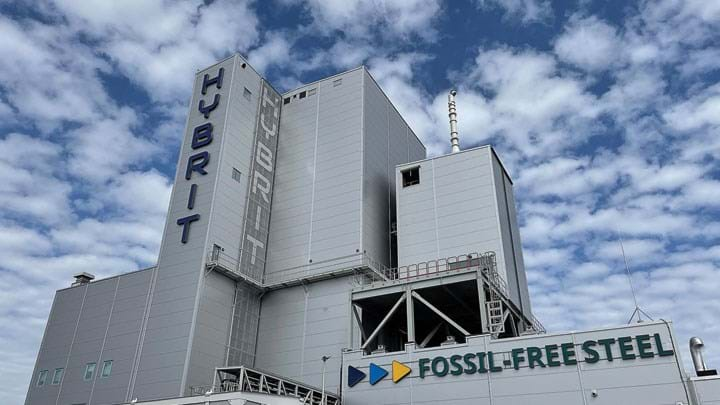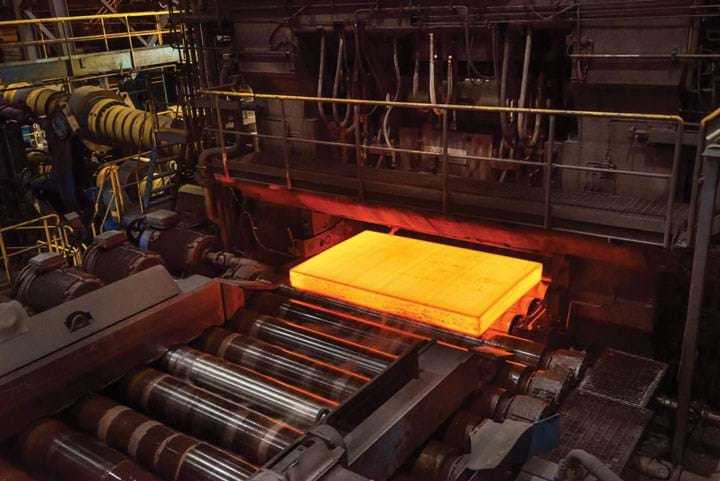Iron Plan: Working Towards Emissions-Free Reduction
Kerry Hebden speaks to innovators piloting green steel production in Sweden, and a second team working on a process to produce metals on the moon
WHAT is “green” steel? Although not a new term, up until now “green” steel simply meant steel production with the lowest carbon footprint currently possible. It’s an ambiguous phrase that without an official definition, can be tailored to the company making the claim. The label is so overused that according to global steelmaking firm SSAB, steel can be called green even if a mere 10% of the total process output is green while the remaining 90% of production output is “as dirty as ever.”
But how “dirty” is dirty? An analysis of data from the IEA estimates that the steel industry contributes more than 10% of global CO2 emissions. That’s because traditional steel production uses blast furnaces (BFs) and basic oxygen furnaces (BOFs) to make iron and crude steel; these furnaces are dependent on coal, specifically metallurgical coal, or metcoal or coking coal as it is also known . Not all coals can be used as metallurgical coals to make coke. Metcoals must have low: ash yield; volatile matter; phosphorous; chlorine; sulfur; and alkali content. Before it can be used in steelmaking, it is heated at around 1,100oC for up to 18 hours to remove water and other impurities such as coal tar and coal gas. The end result is a hard, porous lump of near-pure carbon called coke, which is mechanically strong, and chemically reactive. These qualities, coupled with the intense heat it generates when consumed makes it ideal for smelting iron and steel. But to produce a tonne of steel in a blast furnace requires roughly 500-650 kg of coke, and in 2021 nearly 2bn t of crude steel was produced – the majority of which was by the BF/BOF route. That’s a huge amount of coke used worldwide per year.
The good thing about steel is its capacity to be infinitely recycled without loss of properties or performance, and as such it is the most recycled material in the world today. However, because steel can be in place for a long time before it’s free to use again, recycling will not be enough for the foreseeable future, and 50% iron ore-based steel will still be needed by 2050. When it comes to the raw materials, Australia and Brazil are the top exporters of the 2.5bn t of iron-ore that is mined each year, and approximately 98% of that is used by the steel industry. It seems clear then, that unless a non-fossil fuel alternative to coke that has similar mechanical properties is found, a different approach to steel-making is needed if CO2 emissions across the industry are to be reduced. That future is here, say researchers behind a new steel pilot plant based in Sweden, who are working not just to reduce emissions, but to eliminate them completely.
An analysis of data from the IEA estimates that the steel industry contributes more than 10% of global CO2 emissions


Embracing hydrogen
Dubbed HYBRIT, short for Hydrogen Breakthrough Ironmaking Technology, the project is a joint venture between Europe’s largest iron ore producer, LKAB, one of Europe’s largest energy companies, Vattenfall, and specialised steel manufacturer, SSAB. Following a pre-feasibility study with support from the Swedish Energy Agency in 2016, HYBRIT is now a fully-functioning pilot plant in Luleå which is pumping out about 1 t/h of sponge iron during its trial phase. That might not sound a lot considering that around 300 t/h of pig iron (crude iron) can be produced using blast furnaces, but it is still in its early days and when fully up and running, it should be able to match the output from a blast furnace but without any of its CO2 emissions.
HYBRIT uses a process known as direct-reduced iron (DRI) to produce steel. DRI is the removal of oxygen from iron ore (or other iron bearing materials) in the solid state, ie without melting. Instead of using the CO emitted from the burning coke in a BF to initiate reactions with oxygen in the iron ore, natural gas or syngas is used. Although DRI operates below the melting point of iron, it still requires heating to ~800-1,200°C, but instead of coke, plants can use electricity to generate the heat instead. The last reaction when using natural gas, however, is FeO + CO Fe + CO2, meaning that CO2 is still one of the end products.
DRI is already in use by many of the big steelmakers, but where HYBRIT differs is that instead of using natural gas as a reducing agent, the project uses hydrogen. The reduction of iron ores by hydrogen is a gas-solid reaction which occurs in two or three stages. For temperatures higher than 570°C, hematite (Fe2O3) is first transformed into magnetite (Fe3O4), then into wustite (Fe1-yO), and finally into metallic iron. At temperatures below 570°C, magnetite is directly transformed into iron since wustite, a mineral form of FeO found on the surface of meteorites and in the lower mantel of Earth, is not thermodynamically stable. Most of the reaction features are very similar to that of the reduction by CO, but the end reaction, FeO + H2 → Fe + H2O, means that the only byproduct is water.
DRI is also called “sponge” iron, as removing the oxygen leaves voids in the lumps, fines or pelletised iron that is used for the feedstock, giving it a spongy appearance. And being a highly reduced material – at least 90% of oxygen is removed in the process - sponge iron has a tendency to re-oxidise, so it is often pressed into hot briquetted iron (HBI) to make it more resistant to reoxidation. It is also less corrosive, as HBI is twice as dense as DRI, so it doesn’t absorb as much water.
Recent Editions
Catch up on the latest news, views and jobs from The Chemical Engineer. Below are the four latest issues. View a wider selection of the archive from within the Magazine section of this site.




